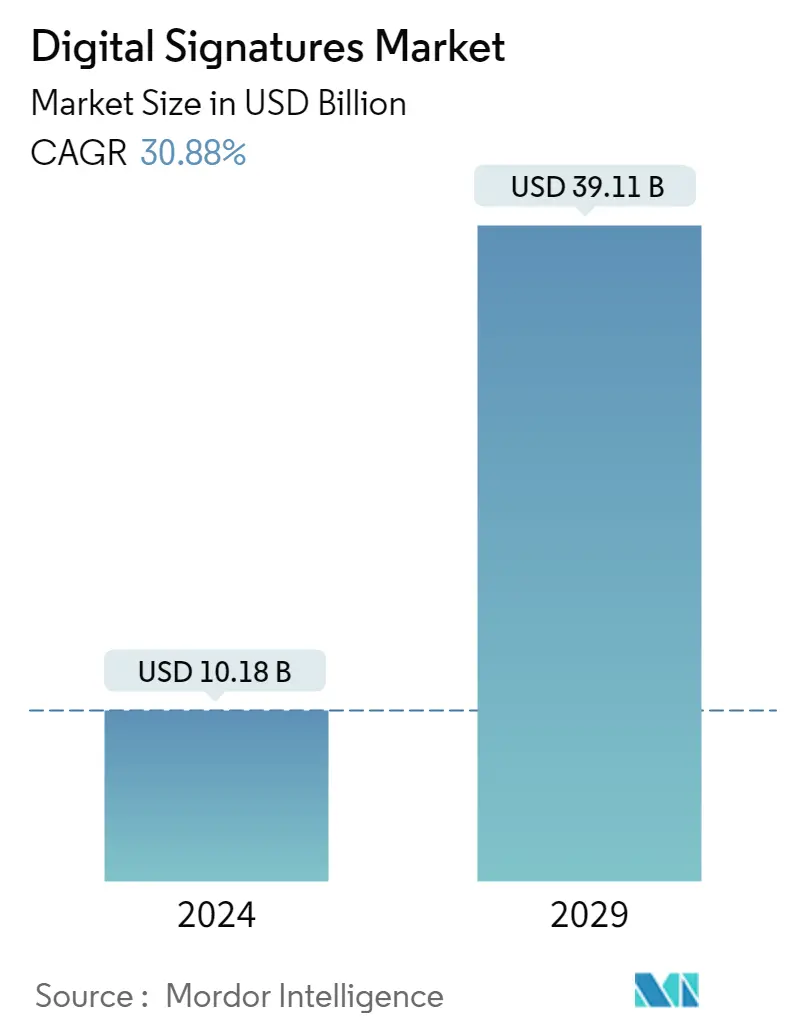Market Size of Digital Signatures Industry

| Study Period | 2019 - 2029 |
| Market Size (2024) | USD 10.18 Billion |
| Market Size (2029) | USD 39.11 Billion |
| CAGR (2024 - 2029) | 30.88 % |
| Fastest Growing Market | Asia-Pacific |
| Largest Market | North America |
Major Players
*Disclaimer: Major Players sorted in no particular order |
Digital Signatures Market Analysis
The Digital Signatures Market size is estimated at USD 10.18 billion in 2024, and is expected to reach USD 39.11 billion by 2029, growing at a CAGR of 30.88% during the forecast period (2024-2029).
Enterprises are shifting from traditional to digital signatures because they reduce the risk of legal disputes and provide stronger evidence.
- There has been a constant need for data security while transmitting sensitive information. Due to the e-commerce and online banking boom, companies needed to secure their networks to gain customer confidence. This has led to a greater and faster rate of adoption rates of digital signatures, which act as the sender's seal of authenticity over any electronic document.
- With the evolution of technology, the way of executing documents has also evolved. Electronic agreements and digital signatures have gained much momentum in recent years with the increasing demand for modern, convenient methods for entering binding transactions. Such developments have significantly changed how these transactions are entered and the execution processes.
- Younger consumers have also been a driving force behind the rise in digital signatures in the financial services industry. Various Gen Z and Millennials worldwide signed financial documents, such as opening a bank account, loan agreement, investment, wealth management, and mortgage agreements during the pandemic, resulting in a burgeoning digital signature demand. Also, government agencies, like the DMV and immigration, have provided more e-signature support for critical documents.
- With the outbreak of COVID-19, the digital signature market is anticipated to exhibit a positive growth rate due to the rise in remote working that shifted the focus from relying on paper-based documentation and increasing the digitalization of the transaction process. Enterprises are seeking business methods that are seamless and efficient and can be done from anywhere. Enterprises are also considering taking document processes online.
Digital Signatures Industry Segmentation
Digital signatures are the most advanced and secure type of electronic signature. One can use them to comply with the most demanding legal and regulatory requirements because they provide the highest levels of assurance about each signer's identity and the authenticity of the documents they sign. It has applications in government, judicial, telecom, e-commerce, and BFSI. The study under consideration covers hardware, software, and service offerings. The study also analyses different deployment modes of digital signatures, such as on-premise and cloud platforms.
The digital signatures market can be segmented by deployment (on-premise and cloud), offering (software, hardware, and service), end-user industry (BFSI, government, healthcare, oil and gas, military and defense, logistics and transportation, research and education, and other end-user industries (real estate, manufacturing, legal, IT, and telecom), and geography (North America, Europe, Asia-Pacific, and the rest of the world).
The market sizes and forecasts are provided in terms of value (USD billion) for all the above segments.
| By Deployment | |
| On-premise | |
| Cloud |
| By Offering | |
| Software | |
| Hardware | |
| Service |
| By End-user Industry | |
| BFSI | |
| Government | |
| Healthcare | |
| Oil and Gas | |
| Military and Defense | |
| Logistics and Transportation | |
| Research and Education | |
| Other End-user Industries (Real Estate, Manufacturing, Legal, IT, and Telecom) |
| By Geography | ||||||
| ||||||
| ||||||
| ||||||
|
Digital Signatures Market Size Summary
The digital signatures market is experiencing significant growth as enterprises transition from traditional methods to digital solutions, driven by the need for enhanced security and efficiency in document processing. The rise of e-commerce and online banking has accelerated the adoption of digital signatures, which provide a secure and verifiable way to authenticate electronic documents. This shift is further propelled by the increasing demand for modern, convenient methods of executing binding transactions, particularly among younger consumers like Gen Z and Millennials. The COVID-19 pandemic has also played a crucial role in this transformation, as remote working necessitated a move away from paper-based documentation towards digital solutions. Government agencies have expanded their support for e-signatures, recognizing their importance in streamlining processes and reducing costs.
The North American region stands out as a leading market for digital signatures, fueled by the adoption of cloud-based solutions and supportive government initiatives like the Uniform Electronic Transactions Act and the Electronic Signatures in Global and National Commerce Act. These regulations have facilitated the widespread use of e-signatures across various transactions, including trade agreements. Major players in the market are continuously innovating to maintain competitiveness, with companies like DocuSign and HelloSign expanding their offerings. The market remains fragmented, with numerous players vying for market share by providing cost-effective and advanced solutions. Collaborations, such as those between IDnow and Adobe Document Cloud, are enhancing the security and efficiency of digital signature processes, further driving market growth.
Digital Signatures Market Size - Table of Contents
-
1. MARKET INSIGHTS
-
1.1 Market Overview
-
1.2 Industry Attractiveness - Porter's Five Forces Analysis
-
1.2.1 Bargaining Power of Suppliers
-
1.2.2 Bargaining Power of Buyers
-
1.2.3 Threat of New Entrants
-
1.2.4 Threat of Substitute Products
-
1.2.5 Intensity of Competitive Rivalry
-
-
1.3 Assessment of COVID-19 Impact on the Industry
-
-
2. MARKET SEGMENTATION
-
2.1 By Deployment
-
2.1.1 On-premise
-
2.1.2 Cloud
-
-
2.2 By Offering
-
2.2.1 Software
-
2.2.2 Hardware
-
2.2.3 Service
-
-
2.3 By End-user Industry
-
2.3.1 BFSI
-
2.3.2 Government
-
2.3.3 Healthcare
-
2.3.4 Oil and Gas
-
2.3.5 Military and Defense
-
2.3.6 Logistics and Transportation
-
2.3.7 Research and Education
-
2.3.8 Other End-user Industries (Real Estate, Manufacturing, Legal, IT, and Telecom)
-
-
2.4 By Geography
-
2.4.1 North America
-
2.4.1.1 United States
-
2.4.1.2 Canada
-
-
2.4.2 Europe
-
2.4.2.1 United Kingdom
-
2.4.2.2 Germany
-
2.4.2.3 France
-
2.4.2.4 Rest of Europe
-
-
2.4.3 Asia-Pacific
-
2.4.3.1 China
-
2.4.3.2 Japan
-
2.4.3.3 South Korea
-
2.4.3.4 Rest of Asia-Pacific
-
-
2.4.4 Rest of the World
-
2.4.4.1 Latin America
-
2.4.4.2 Middle East and Africa
-
-
-
Digital Signatures Market Size FAQs
How big is the Digital Signatures Market?
The Digital Signatures Market size is expected to reach USD 10.18 billion in 2024 and grow at a CAGR of 30.88% to reach USD 39.11 billion by 2029.
What is the current Digital Signatures Market size?
In 2024, the Digital Signatures Market size is expected to reach USD 10.18 billion.

